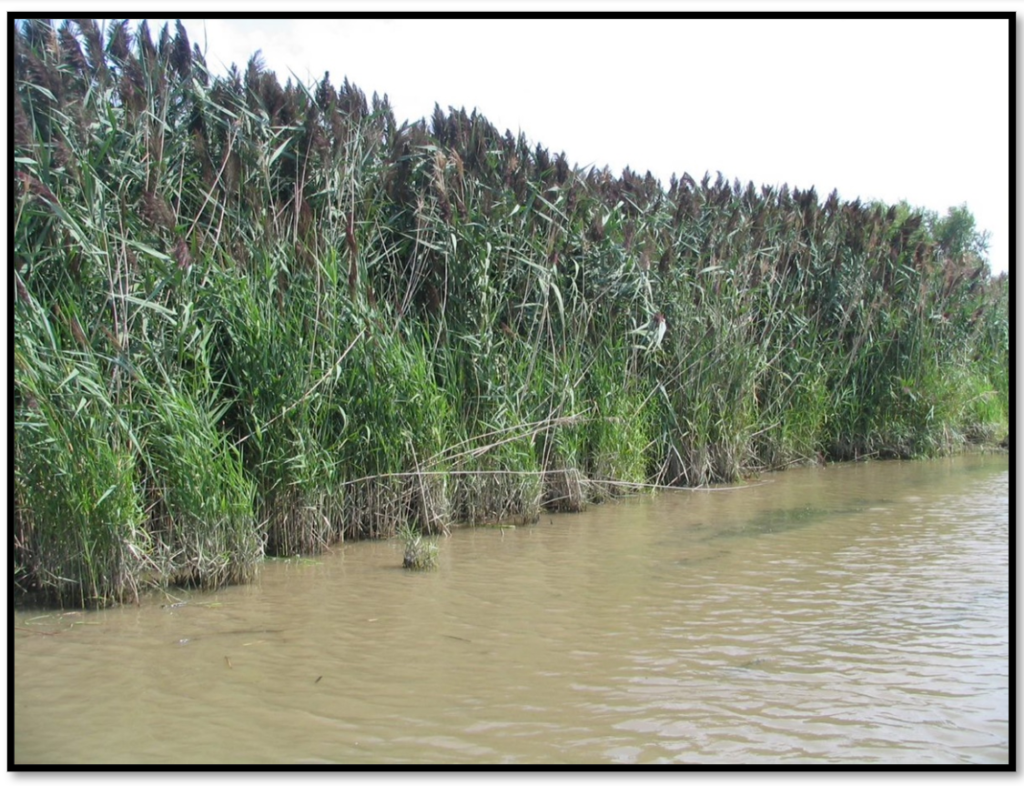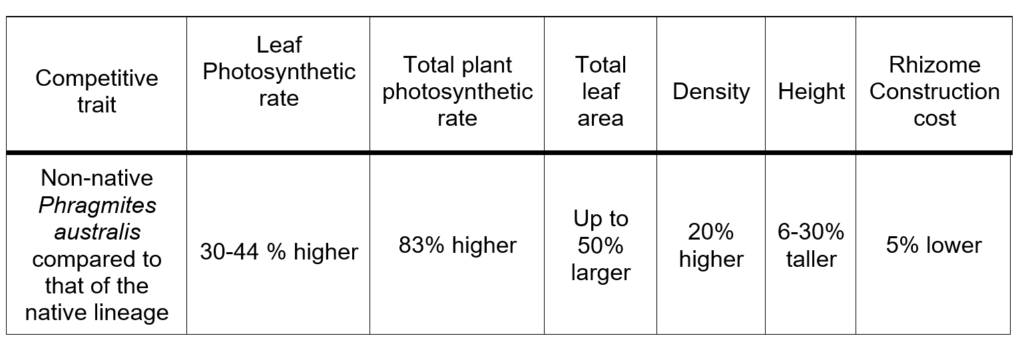June 8, 2022 – Theresa Gruninger, Great Lakes Commission
A question that haunts us all. Non-native Phragmites australis is famous for being incredibly widespread, found within all 48 U.S. continental states, this grass has no problem making a home just about anywhere (Figure 1). Those who have to identify Phragmites, likely know that the native and non-native lineages look annoyingly similar (although there are some key identifying traits between the two). But once you become a master at identifying the two, you may be thinking to yourself, “so where is all the native Phragmites?”, and if it is physically similar to the non-native species, “why don’t we see more native patches in wetlands, retention ponds or taking over recently cleared construction sites?”

Figure 1. The green represents the states and provinces where non-native Phragmites australis is found. Image from EDDMapS. 2022. Early Detection & Distribution Mapping System. The University of Georgia – Center for Invasive Species and Ecosystem Health
The answer to these questions can be found deep in the Great Lakes Phragmites Collaborative (GLPC) webinar archives.
In 2014, Dr. Thomas Mozdzer gave a presentation called “Effects of Elevated CO2 and Nitrogen Pollution on Phragmites australis”. The presentation in its entirety is fantastic and can (and should) be watched here. But what really stood out, was all the information peppered into the presentation that really gave the audience insight as to why non-native Phragmites is a stronger competitor compared to their native counterpart. Below is a brief synopsis of what Dr. Mozdzer and his fellow researchers found out.
In 2005 and 2006, Dr. Mozdzer and his colleagues conducted a field study in Kings Creek marsh on the eastern shore of Maryland. In this particular marsh, Dr. Mozdzer was able to study native and non-native Phragmites growing side by side to better understand the ecophysiological and morphological differences between the two. Here the researchers were able to measure the photosynthetic rates of the two lineages and discovered some interesting results. The non-native plant’s leaves were found to have a 30-44% greater photosynthetic rate than native Phragmites! The higher the photosynthetic rate a plant has, the more carbon plants can fix (incorporate into their biomass), and ultimately the larger the plants can grow and spread. Dr. Mozdzer found that his field results were consistent with other studies, which noted photosynthetic rates differed between native and non-native Phragmites between 12-80%. The total leaf area of the two lineages were measured and it was noted that non-native Phragmites‘ leaf area was approximately 50% greater. So not only does non-native Phragmites have a higher photosynthetic rate compared to the native species, but it also has larger leaves that allow the plant to take in even more carbon! They also discovered that the non-native leaves had approximately double the amount of chlorophyll during the growing season (chlorophyll is the pigment behind plants getting their iconic green color). This finding makes sense, as plants that have a higher chlorophyll content also have a higher photosynthetic rate. One of the key identifiers when comparing native to non-native Phragmites, is the leaves of native plants often have lighter coloration (Figure 2).

Figure 2. The picture shows leaves from non-native (top) and native (bottom) Phragmites australis plants. Note the differences in chlorophyll pigment. Photo credit: Katherine Hollins
Dr. Mozdzer and his team didn’t stop there, they also looked at density differences between the two lineages. They found on average the non-natives had a 20% greater density AND that the plants were generally taller (6-30%) than their native counterpart. When you take into account the increased leaf area and the higher density and height, the researchers found that non-native Phragmites boasted about two times the biomass compared to native Phragmites. Okay, so if having double the biomass already doesn’t sound great for the native Phragmites, trying to compete for resources like light and space. But what happens when all of these different metrics are applied together? To do this, they integrated the photosynthetic rate and multiplied it over the leaf canopy to estimate the photosynthetic rate of an individual plant. What they found was that non-native Phragmites have an 83% increase in photosynthesis per individual plant compared to that of native Phragmites. This means that a non-native Phragmites plant can fix 83 times more carbon per second than their native counterpart! Add in the fact that non-native Phragmites grow in denser stands, and it is estimated that non-native Phragmites has a 112% higher photosynthetic rate per m2 than the native lineage (Figure 3). All of these small differences in photosynthetic rate, when multiplied out, give non-native Phragmites a pretty large advantage.

Figure 3. A dense monotypic stand of non-native Phragmites
Another way to understand the difference in competitive advantages between native and non-native Phragmites is to look at construction cost. Construction cost, or the amount of energy required to build plant tissue, “has yielded insights into the strategies used by plants for carbon acquisition (investment in leaf longevity, payback time for the investment, light harvesting area, etc.) and has thereby helped to explain patterns in growth at the individual and population levels” (Caplan et al. 2014). The construction cost of leaves (the normal go-to for construction cost analysis) between native and non-native Phragmites, does not significantly differ, however there is a difference in the plant’s rhizome. Native Phragmites had a significantly higher construction cost (about 5%) in the creation of rhizomes compared to that of non-native Phragmites. This has major implications, as this low carbon construction cost in the rhizomes of non-native plants can be paid back quickly, allowing for accelerated growth. Basically, if it takes a plant a lot less energy to make rhizomes, the plant can spread clonally faster, which is an important factor in terms of invasion.

Table 1. Summary of the ecophysiological and morphological differences found between non-native and native Phragmites australis
While the success behind non-native Phragmites is more complex than the few examples listed here (a multitude of factors such as soil nutrient availability, nutrient competition, salinity, and modes of reproduction are also thought to play a role), it is obvious that genetically inherited ecophysiological and morphological differences between lineages explain a great deal of non-native Phragmite’s competitive advantage (Table 1).
Since this 2014 webinar, there have been additional studies that also look at how hybrid Phragmites faired in terms of competitive advantages. Hybrid Phragmites are the result of the crossing between two genetically distinct lineages (native Phragmites australis ssp americanus and non-native Phragmites australis ssp australis) to create a genetically distinct population. In 2019, the article by Williams et al. 2019 compared differences in stand morphology, seed production and mass, and rhizome and seed viability of native, invasives and hybrid Phragmites in California, Nevada, Utah and Arizona. It turns out that hybrid Phragmites are likely to inherit the beneficial morphological and reproductive traits from both parents. Non-native and hybrid plants were found to have higher inflorescence (those fluffy seed heads) densities and greater percent coverage and stem density compared to the native counterpart. Hybrids in particular have an average of 295% to 454% more seeds per inflorescence than native and non-native lineages! Learn more about hybridization in our blog “Hybrid Phragmites australis in North America” .
For me details on this topic, see Dr. Mozdzer’s 2014 presentation and the associated research articles.
Joshua S. Caplan, Christine N. Wheaton, Thomas J. Mozdzer, Belowground advantages in construction cost facilitate a cryptic plant invasion, AoB PLANTS, Volume 6, 2014, plu020, https://doi.org/10.1093/aobpla/plu020
Thomas J. Mozdzer, Jacques Brisson, Eric L. G. Hazelton, Physiological ecology and functional traits of North American native and Eurasian introduced Phragmites australis lineages, AoB PLANTS, Volume 5, 2013, plt048, https://doi.org/10.1093/aobpla/plt048
Thomas J. Mozdzer, Joseph C. Zieman, Ecophysiological differences between genetic lineages facilitate the invasion of non-native Phragmites australis in North American Atlantic coast wetlands, Journal of Ecology, Volume 98 (451-458), 2010, https://doi.org/10.1111/j.1365-2745.2009.01625.x
Jared Williams, Adam M. Lambert, Randy Long, Kristin Saltonstall, Does hybrid Phragmites australis differ from native and introduced lineages in reproductive, genetic, and morphological traits? American Journal of Botany, Volume 106:1(29-41), 2019, https://doi.org/10.1002/ajb2.1217
Other Literature Cited
Karin M. Kettenring, Karen E. Mock, Genetic diversity, reproductive mode, and dispersal differ between the cryptic invader, Phragmites australis, and its native counterpart, Biological Invasions, Volume 14 (2489-2504), 2012, https://doi.org/10.1007/s10530-012-0246-5
Thomas J. Mozdzer, Adam J. Langely, Peter Mueller, Patrick J. Megonigal, Deep rooting and global change facilitate spread of invasive grass, Biological Invasions, Volume 18 (2619-2631), 2016, https://doi.org/10.1007/s10530-016-1156-8
Amy L. Price, Jeremie B. Fant, Daniel J. Larkin, Ecology of native vs. introduced Phragmites australis (common reed) in Chicago-area wetlands, Wetlands, Volume 34 (369-377), 2014, https://doi.org/10.1007/s13157-013-0504-z
